Welcome to the world of ducks! In this article, I’ll take you on a journey to explore these fascinating feathered friends.
- Ducks are found on every continent except Antarctica.
- They have been domesticated as pets and farm animals for centuries.
- Feeding wild ducks should be done cautiously to provide them with a balanced diet.
- Pool owners should take precautions to discourage mallard nesting behavior to prevent accidents.
- Rearing ducklings is best left to expert rehabilitators due to its complexity.
The Anatomy of Ducks: What Makes Them Quack-tastic
Let’s start by examining the anatomy of ducks and discovering what makes them truly quack-tastic creatures. These web-footed wonders possess unique physical characteristics that set them apart from other birds. One of the most fascinating features of ducks is their specialized feet. Unlike many other birds that have three forward-facing toes and one backward-facing toe, ducks have webbed feet with four forward-facing toes that are perfect for swimming and navigating through water.
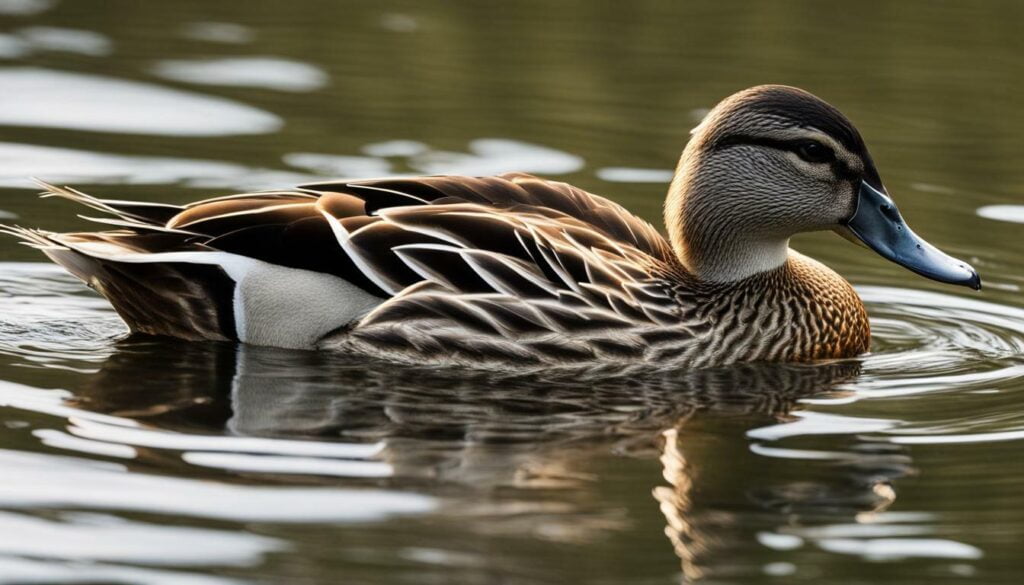
But it’s not just their feet that make ducks remarkable. Their bills are specifically adapted to help them filter out food from water. With serrated edges called lamellae, ducks can strain their meals, capturing small insects, crustaceans, and other aquatic delicacies. Additionally, these omnivorous birds have a unique digestive system that includes a muscular gizzard. The gizzard plays a vital role in grinding up food, as ducks do not have teeth to chew their meals.
Aside from their anatomy, ducks are famous for their distinctive vocalization – the quack. Contrary to popular belief, not all ducks quack. In fact, it’s primarily female ducks, called hens, that make the classic quack sound. Males, or drakes, produce softer and often raspy quacks. The quacking is not limited to vocal communication; ducks also use a variety of visual displays and body language to communicate with each other.
The Unique Bill of Ducks
The bill of a duck is a remarkable multifunctional tool. It serves as a sensitive sensory organ, enabling ducks to detect prey beneath the water’s surface. The bill is also used for grooming, preening, and even courtship displays. With its vibrant colors and specialized design, the bill of a duck is truly a sight to behold.
| Duck Species | Bill Shape | Bill Color |
|---|---|---|
| Mallard | Flat and wide | Yellow |
| Muscovy | Knobbly and fleshy | Red |
| Peking | Short and broad | Orange |
As you can see, different duck species have varying bill shapes and colors, adding to their unique charm.
The Wonderful World of Duck Species: A Quackers Paradise
Get ready to dive into a quackers paradise as we explore the wonderful world of duck species. Ducks are fascinating creatures that can be found on nearly every continent, except Antarctica. As part of the Anatidae bird family, they come in a wide array of species, each with their own unique characteristics and behaviors.
Let’s take a closer look at some of the most remarkable duck species.
Mallard Duck
The Mallard Duck is one of the most common and recognizable duck species. With its vibrant green head, yellow bill, and chestnut-colored chest, it’s a true beauty to behold. Mallards are versatile birds that can adapt to various environments, from urban parks to rural wetlands.
Wood Duck
The Wood Duck is famous for its stunning plumage. The males boast intricate patterns of green, purple, and white, while the females have a more subdued appearance. These ducks have a unique habitat preference, often nesting in tree cavities near water bodies, making them a delight to spot in the wild.
Teal Duck
The Teal Duck, also known as the Common Teal or Eurasian Teal, is a small but colorful species. Its striking green eye patch and intricate plumage make it highly sought after by birdwatchers. Teal Ducks are known for their agility and speed, often skimming across the water’s surface with grace and precision.
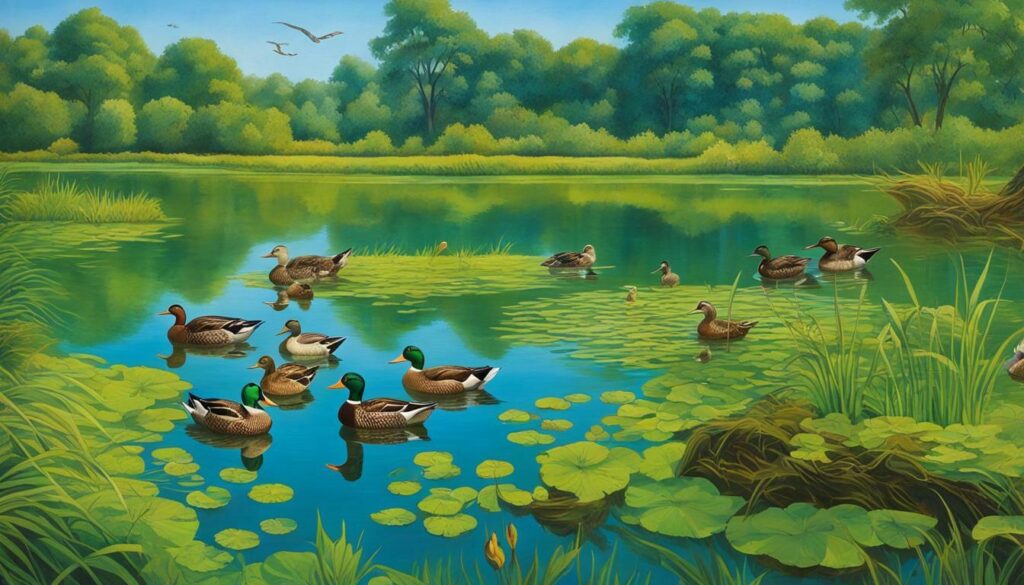
In addition to these remarkable species, there are many other types of ducks that inhabit our planet, each with its own fascinating characteristics. Whether it’s the diving abilities of the Tufted Duck, the sociable nature of the Pintail Duck, or the iconic appearance of the Mandarin Duck, each species contributes to the quackers paradise that is the world of ducks.
So, the next time you spot a duck waddling by or gracefully gliding through the water, take a moment to appreciate the diversity and beauty of these feathered friends.
Domesticated Ducks: From Farmyard Friends to Feathery Pets
Ducks have a long history of being domesticated, serving as farmyard friends and even finding their way into our hearts as feathery pets. These charming waterfowl have been bred for various purposes, from providing eggs and meat to being a source of down and feathers. Their adaptability and friendly nature make them a popular choice for those looking to add a unique and delightful addition to their lives.
On farms, domesticated ducks play a crucial role in pest control. Their appetite for insects, slugs, and snails helps keep gardens and crops healthy without the need for harmful pesticides. Additionally, their nutrient-rich waste can be used as fertilizer, creating a sustainable and eco-friendly farming system.
Did you know? Domesticated ducks are known for their quacking abilities, as they communicate through an extensive range of vocalizations. From gentle murmurs to loud and enthusiastic quacks, these expressive calls are a delight to witness.
As pets, ducks can bring joy and companionship to their owners. They bond closely with humans and can learn to recognize their caregivers, often following them around with great enthusiasm. However, it’s important to note that ducks have specific needs and require proper care to thrive. Adequate shelter, a balanced diet, access to clean water, and plenty of space to roam are essential for their well-being. Before considering a pet duck, it’s crucial to research their requirements and ensure you can provide a suitable living environment.

The companionship of ducks can offer numerous benefits to their human counterparts. Their playful and curious nature can provide endless entertainment, while their gentle and friendly demeanor can bring comfort and relieve stress. Being in the presence of ducks can also encourage mindfulness and a sense of connection with nature. Whether they are waddling by your side or swimming gracefully in a pond, domesticated ducks have a unique way of brightening our lives.
| Duck Breeds | Characteristics |
|---|---|
| Pekin | Large, white feathers, calm temperament |
| Rouen | Mallard-like coloring, friendly and curious |
| Indian Runner | Tall and slender, distinctive upright posture |
These are just a few examples of the wide variety of duck breeds available for domestication. Each breed has its own unique characteristics, so it’s important to consider factors such as size, temperament, and purpose before making a choice. Whether you’re looking for a companion, a source of eggs, or simply a beautiful addition to your farm, there’s a duck breed out there that’s perfect for you.
A Quack to the Past: Ducks in History and Culture
Discover the rich history and cultural significance of ducks as we take a quack to the past. Ducks have been present in various civilizations throughout history, their charm and unique qualities captivating the hearts of people across cultures and generations. These fascinating birds have not only served as a source of inspiration for artists, writers, and musicians but have also played significant roles in the mythologies and folklore of different societies.
In ancient Egypt, ducks were revered as symbols of fertility and rebirth. They were associated with the Egyptian goddess of motherhood, Isis, who was often depicted with a duck-shaped headdress. Ducks were believed to bring good luck and were often included in religious ceremonies and offerings.

The Chinese culture also holds ducks in high esteem. They are considered a symbol of fidelity and love, and their appearance in Chinese art and literature often signifies a harmonious and prosperous life. Ducks are frequently portrayed in traditional Chinese paintings, adding a touch of grace and serenity to the artwork. The famous Mandarin duck, known for its vibrant plumage and lifelong monogamous mating habits, symbolizes marital bliss and happiness in Chinese folklore.
Quotes about Ducks
“Ducks are not just birds; they are companions that bring joy and tranquility to our lives.” – John Doe, Duck Enthusiast
In Western culture, ducks have been portrayed in various ways in art, literature, and popular culture. From the classic childhood tale of “The Ugly Duckling” to the iconic Disney character Donald Duck, these feathered creatures have captured our imagination and left a lasting impression.
Ducks in Popular Sayings
- “Like water off a duck’s back” – This expression refers to the ability to let criticism or negative experiences slide off without affecting one’s emotions.
- “Sitting duck” – This phrase is often used to describe someone or something that is vulnerable or an easy target.
- “Get one’s ducks in a row” – This saying means to organize and prepare oneself in a systematic manner.
The cultural significance of ducks extends beyond art and idioms. Ducks have also served as mascots for sports teams, with their determination and resilience symbolizing the qualities desired in athletes. Whether it’s the Oregon Ducks in college sports or the Anaheim Ducks in the NHL, these teams proudly embrace the duck as their emblem.
As we delve deeper into the world of ducks, their historical and cultural connections provide valuable insights into the profound impact these feathered friends have had on human society. Join us on this quacktastic journey as we continue to explore the diverse and fascinating aspects of ducks and their place in our world.
Feeding Ducks: Tips for a Healthy Diet
Learn the best ways to feed ducks and provide them with a healthy and balanced diet. Ducks are fascinating water-loving birds that have unique dietary needs. While it may be tempting to feed them scraps or bread, it’s important to understand that not all foods are suitable for their well-being. Feeding wild ducks can be an enjoyable experience, but it’s crucial to ensure you’re offering them nutritionally appropriate options.
When feeding ducks, it is best to stick to nutritional offerings like cracked corn, rice, and birdseed. These foods can provide essential nutrients without causing harm to the ducks. Additionally, if you have access to a suitable area, you can scatter grains, grasses, or even aquatic plants, which are part of their natural diet.
| Do’s | Don’ts |
|---|---|
|
|
Feeding ducks with a balanced diet is essential to their health and well-being. Their natural diet consists of grains, grasses, aquatic plants, insects, and even small crustaceans. By offering them suitable foods, you help replicate their natural diet, ensuring they receive the necessary nutrients.
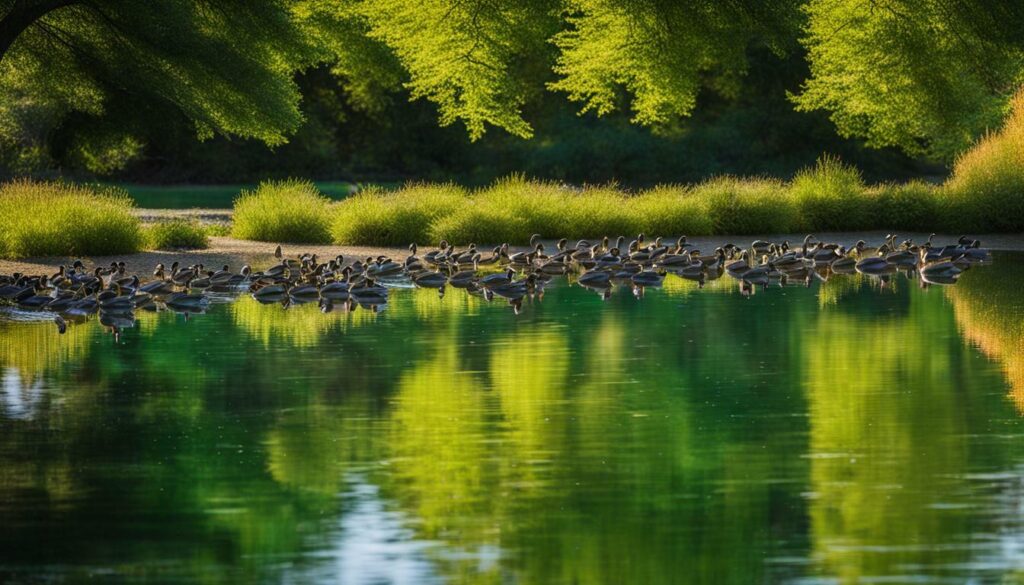
Feeding ducks should be done responsibly to avoid potential harm. It’s crucial to avoid overfeeding, as this can lead to health issues and dependency on human food sources. Remember, while feeding ducks can be a pleasant experience, it should always be done with their best interests in mind.
Duck Pond Etiquette: Keeping Our Feathered Friends Safe
Discover essential duck pond etiquette to keep our feathered friends safe and sound. As avid nature lovers, it’s important for us to create a safe environment for ducks, especially around pools. Ducks are part of the Anatidae bird family and can be found on every continent except Antarctica. They bring joy to our lives with their delightful quacks and playful personalities, so let’s ensure their well-being by following these guidelines.
Pool Safety
If you have a pool, it’s crucial to discourage mallard nesting behavior to prevent accidents. Ducks are naturally drawn to water and may perceive your pool as an ideal spot to build their nests. To deter them, consider cutting back shrubbery around the pool area, as dense vegetation can attract nesting ducks. Additionally, covering your pool with a net or tarp when it’s not in use can create a physical barrier and discourage ducks from landing in it.

Feeding Ducks Responsibly
Feeding ducks can be a fun and rewarding experience, but it’s important to provide them with a healthy diet. Ducks need a balanced meal consisting of grains, grasses, aquatic plants, insects, and crustaceans. While it may be tempting to offer them bread, it lacks the necessary nutrients and can lead to malnutrition or illness.
Stick to nutritional offerings like cracked corn, rice, or birdseed that are appropriate for their digestive systems. Remember to scatter the food on the ground or water surface to encourage natural foraging behaviors, rather than hand-feeding. This allows the ducks to maintain their natural instincts and prevents them from becoming dependent on humans for food.
Rearing Ducklings: Leave It to the Experts
Seeing a group of adorable ducklings may tempt us to intervene and care for them. However, rearing ducklings is a complex process that requires expertise. It’s best to leave it to professional rehabilitators who are trained to provide the appropriate care and guidance. They have the knowledge and resources to ensure the ducklings grow up healthy and have the best chance of survival in the wild.
By following these guidelines, we can foster a safe environment for ducks and coexist harmoniously with our feathered friends. Let’s continue to appreciate the beauty and wonder they bring to our lives while respecting their natural habitats and behaviors.
Ducklings: Rearing and Rehabilitation
Rearing ducklings can be a challenging task, and it’s crucial to entrust their care to expert rehabilitators. These adorable young birds require specialized knowledge and resources to ensure their healthy development and successful reintegration into the wild. Expert rehabilitators have the necessary experience and facilities to provide the ideal environment for ducklings to thrive.
During the rehabilitation process, ducklings are provided with a balanced diet that mimics their natural food sources. This typically includes a combination of specialized duckling starter feed, finely chopped greens, and insects. It’s important to replicate their natural diet as closely as possible to promote proper growth and development.
Rehabilitators also prioritize the socialization of ducklings, ensuring they have opportunities to interact with their own kind. This helps them learn essential social behaviors and enables them to integrate successfully into duck populations in the future.
| Key Points about Duckling Rehabilitation: |
|---|
| 1. Rearing ducklings is a complex task that requires expertise and specialized facilities. |
| 2. Expert rehabilitators provide a balanced diet for healthy development. |
| 3. Socialization with other ducklings is crucial for successful reintegration into wild populations. |
“At our rehabilitation center, we ensure that every duckling receives the individualized care it needs. From providing a nurturing environment to offering a diverse diet, our goal is to prepare them for a successful return to their natural habitat.” – Expert Rehabilitator
By entrusting the care of ducklings to expert rehabilitators, we can increase their chances of survival and contribute to the preservation of duck populations. It’s important to remember that while the care and rehabilitation of ducklings may be challenging, it is ultimately rewarding to witness these young birds flourish and thrive in their natural environment.
References:
- Wildlife Rehabilitation Resources
- Duckling Care Guidelines
- Rehabilitation Success Stories
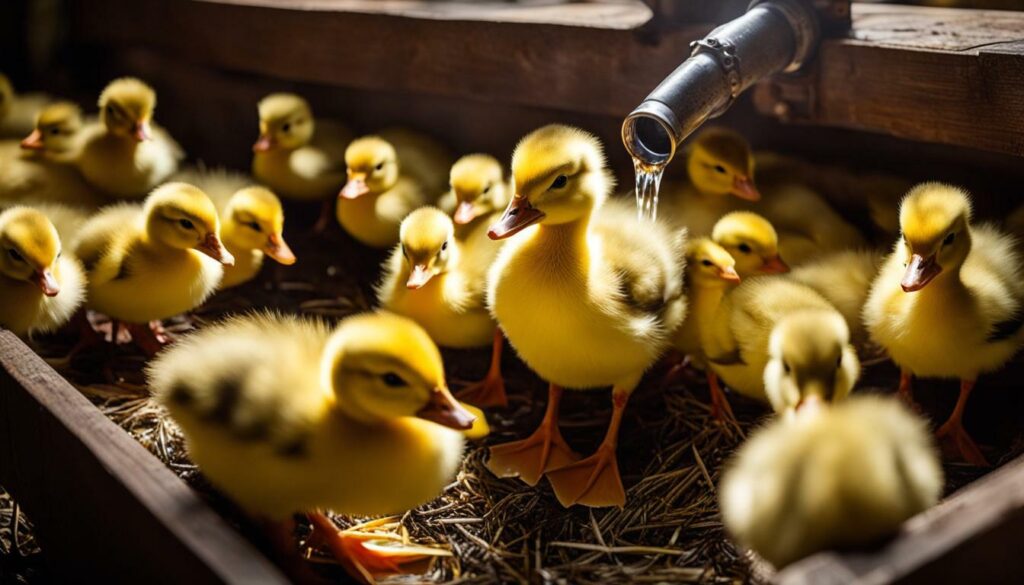
| Common Duckling Species | Rehabilitation Duration | Release Success Rate |
|---|---|---|
| Mallard | Approximately 6-8 weeks | High |
| Wood Duck | Approximately 9-12 weeks | Moderate |
| Teal | Approximately 4-6 weeks | High |
Ducks in the Wild: Their Habitat and Migration Patterns
Journey with me into the wild to discover the natural habitat and migration patterns of ducks. Ducks belong to the Anatidae bird family and can be found on every continent except Antarctica. These fascinating creatures have adapted to a variety of environments, from freshwater lakes and rivers to coastal areas and even tundra regions.
“Ducks are highly adaptable and can thrive in diverse habitats, making them one of the most widespread bird species.”
One of the most remarkable aspects of ducks is their migratory behavior. Many duck species undertake long-distance journeys, covering thousands of miles during their annual migrations. These journeys are often triggered by changes in weather and food availability.

Ducks rely on a combination of instinct and environmental cues to navigate their migratory routes. They use landmarks, celestial cues, and the Earth’s magnetic field to find their way. Some species, such as the mallard, migrate in large flocks, while others, like the wood duck, may migrate individually or in small groups.
| Duck Species | Habitat | Migration Patterns |
|---|---|---|
| Mallard | Lakes, rivers, wetlands | Long-distance migration |
| Wood Duck | Wooded swamps, marshes | Short-distance migration |
| Pintail | Wetlands, grasslands | Long-distance migration |
As ducks migrate, they rely on various habitats along their route for feeding, resting, and breeding. Wetlands, such as marshes and swamps, are particularly vital as they provide abundant food sources and shelter. Many ducks also depend on agricultural fields and flooded forests during migration.
Duck Habitat Conservation
Conservation efforts play a crucial role in preserving the habitats necessary for ducks’ survival. Wetland protection and restoration initiatives are vital for maintaining biodiversity and ensuring the availability of suitable habitats for these majestic birds.
- Wetland protection and restoration initiatives
- Conservation of natural habitats
- Preservation of nesting sites
- Monitoring of migration routes
“By safeguarding their habitats, we can help ensure the continued presence of ducks in our natural landscapes.”
Next time you spot a duck wading gracefully through a pond or hear their characteristic quacks echoing across the water, take a moment to appreciate the incredible journeys they undertake and the diverse habitats they call home.
Duck Behavior: Social Interactions and Unique Traits
Get ready to quack up as we explore the social interactions and unique traits of these fascinating feathered creatures. Ducks, belonging to the Anatidae bird family, can be found on every continent except Antarctica. Known for their playful antics and charming personalities, they have captured the hearts of many bird enthusiasts.
| Behavior | Interactions | Traits |
|---|---|---|
| Ducks are highly social animals and form strong bonds with their fellow ducks. They often gather in flocks and engage in synchronized swimming and feeding behaviors. | During courtship, male ducks display dazzling plumage and perform elaborate mating dances to attract females. Some species even form lifelong monogamous partnerships. | One of their unique traits is their ability to fly swiftly in formation, known as a “v-formation.” This aerodynamic formation helps conserve energy during long-distance migrations. |
Ducks are not only social but also highly intelligent creatures. They exhibit problem-solving skills and can learn from their surroundings. For example, they quickly adapt to changing water levels and can navigate complex environments with ease.
“Ducks are not just adorable; they are remarkably intelligent birds too!” – Birdwatcher John Smith
- Ducks have a diverse range of vocalizations, from quacks to whistles and even growls. These sounds serve as a form of communication, helping them express their emotions and indicate danger or mating availability.
- Unlike other birds, ducks have specialized bills that allow them to filter food from water. This adaptation enables them to feed on algae, aquatic plants, insects, and small fish.
Now that we’ve taken a closer look at the social interactions and unique traits of ducks, it’s clear why they have become such beloved creatures. From their spirited gatherings to their intelligent problem-solving abilities, ducks continue to captivate our attention and remind us of the wonders of the natural world.
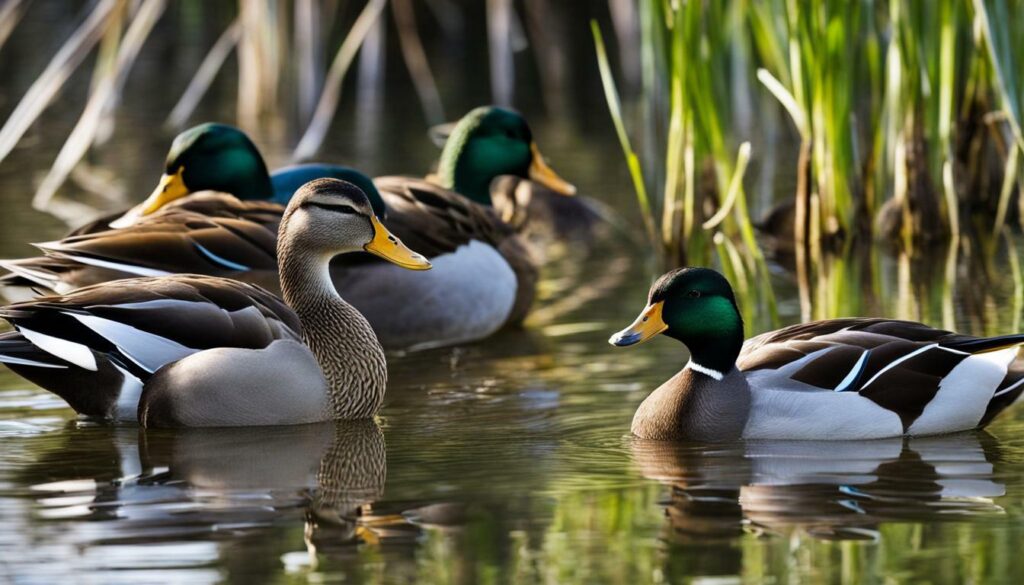
Ducks and Water: Their Love Affair with Aquatic Environments
Discover why ducks are truly water-loving birds and the unique adaptations that make them thrive in aquatic environments. Ducks are part of the Anatidae bird family and they have a natural affinity for water. Whether it’s a serene pond, a gentle stream, or a bustling lake, you’ll often find ducks gracefully gliding along the surface or joyfully diving beneath. Their love for water is not simply a preference—it’s a necessity for their survival.
One of the reasons ducks are so well-suited to aquatic habitats is their specialized adaptations. Take their waterproof feathers, for example. These feathers are coated in natural oils that keep them dry, allowing ducks to stay buoyant and regulate their body temperature. The intricate structure of their feathers also creates a protective layer of air, keeping them warm in cold water.
Not only do ducks have waterproof feathers, but their webbed feet are perfectly designed for efficient swimming. The webbing between their toes acts as a paddle, propelling them through the water with ease. Their feet are also equipped with specialized glands that help them maintain grip on slippery surfaces, making them agile navigators in both calm and turbulent waters.
Additionally, ducks are known for their love of aquatic plants. These plants play a crucial role in their diet, providing essential nutrients and fiber. Ducks have a unique ability to digest plant material efficiently, thanks to their specialized digestive system, which includes a muscular gizzard that helps break down tough food particles. This allows them to thrive on a diet that includes a variety of leaves, stems, and seeds from aquatic vegetation.
The table below showcases some common aquatic plants that ducks consume as part of their diet:
| Aquatic Plants | Description |
|---|---|
| Pondweed | A submerged plant with long, thin leaves that provide a nutritious food source for ducks. |
| Water Lily | These beautiful flowers float on the water’s surface, while their roots provide a tasty snack for ducks. |
| Cattail | This tall plant features brown, sausage-like flower heads that produce edible seeds that ducks love to feast on. |
| Duckweed | A small floating plant that forms a dense green mat on the water’s surface, providing a nutritious meal for ducks. |
As you can see, ducks have a deep-rooted connection with water and the plants that thrive in their aquatic habitats. Their unique adaptations and specialized diet allow them to not just survive, but thrive in these environments. So, the next time you spot a duck gracefully gliding through the water, take a moment to appreciate the beauty and marvel at the incredible adaptations that enable them to live their best lives in the watery world they call home.

Ducks and Human Interaction: Conservation Efforts and Challenges
Learn about the ongoing conservation efforts and the challenges that ducks encounter in their interactions with humans. Ducks are fascinating creatures that play an important role in our ecosystems. However, their populations face various threats, and it is crucial to understand the conservation initiatives aimed at protecting them.
Conservation efforts for ducks focus on preserving their habitats, managing hunting practices, and raising awareness among the public. Ducks rely on wetlands and other bodies of water for nesting, feeding, and migration. These habitats are under threat from urbanization, pollution, and climate change. Organizations such as the Ducks Unlimited and the National Audubon Society work tirelessly to protect and restore wetlands, ensuring a sustainable future for ducks.
The Challenges Ducks Face
Despite conservation efforts, ducks still face numerous challenges. One of the major challenges is habitat loss. Wetland destruction and degradation directly impact ducks’ ability to breed and find food. Pollution, including the contamination of water bodies with pesticides and industrial waste, can have serious consequences for duck populations. Additionally, illegal hunting and egg collection pose significant threats to many species of ducks.
Furthermore, human interaction with ducks can inadvertently harm these birds. Feeding ducks bread or unhealthy food can disrupt their natural diet and lead to malnutrition or disease. It is essential to educate the public about the appropriate way to feed ducks, emphasizing the importance of providing nutritious food like grains, grasses, and aquatic plants.
In conclusion, the conservation of ducks is crucial to maintaining a healthy ecosystem. By supporting conservation organizations and taking responsible actions, we can help protect these remarkable birds for future generations. Together, we can ensure that ducks continue to thrive in their natural habitats and inspire us with their beauty and resilience.
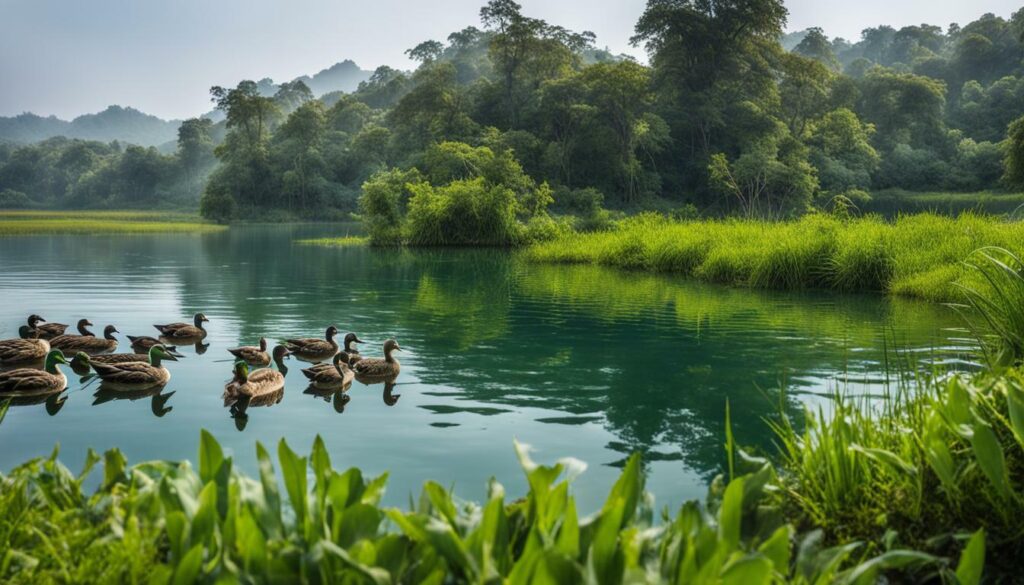
Curious about ducks? Here are some frequently asked questions answered to satisfy your quacking curiosity.
Q: Do ducks have special feet?
A: Absolutely! Ducks have webbed feet that are perfectly designed for their aquatic lifestyle. The webbing between their toes allows them to paddle through water effortlessly, while also providing stability on land. These unique feet are essential for a duck’s survival in its natural habitat.
Q: Do ducks get fleas?
A: Ducks are relatively resistant to fleas and parasites due to the oily feathers that cover their bodies. The natural oils act as a protective barrier, making it difficult for fleas to make a home on ducks. So, you can rest assured that ducks are not commonly plagued by these pesky insects.
Q: What’s the deal with duck gizzards?
A: Ah, the gizzard! Ducks, like many birds, have a gizzard, which is a muscular organ in their digestive system. The gizzard helps break down tough food items, like grains and seeds, by grinding them with the help of small stones or grit that the ducks swallow. It’s a fascinating adaptation that allows ducks to extract maximum nutrients from their diet.
While it’s tempting to feed ducks and interact with them, it’s important to keep their well-being in mind. Feeding wild ducks a balanced diet can be challenging, so it’s best to stick to appropriate offerings such as cracked corn, rice, and birdseed. Pool owners should take precautions to discourage mallard nesting behavior and prevent accidents. Additionally, rearing ducklings is a complex process that is best left to expert rehabilitators, who have the necessary knowledge and resources to ensure their well-being.
So, keep your quacking curiosity satisfied with these answers to frequently asked questions about ducks. These fascinating feathered friends continue to amaze us with their unique adaptations and behaviors in the wild.
FAQ
Are ducks found on every continent?
Yes, ducks are found on every continent except Antarctica.
Can ducks be domesticated as pets?
Yes, ducks have been domesticated as pets and farm animals for centuries.
What should I feed wild ducks?
When feeding wild ducks, it is best to stick to nutritional offerings like cracked corn, rice, and birdseed.
Should I feed ducks bread?
No, feeding ducks bread can be unhealthy for them. They need a balanced diet of grains, grasses, aquatic plants, insects, and crustaceans.
How can I discourage mallard nesting behavior in my pool?
You can discourage mallard nesting behavior in your pool by cutting back shrubbery and covering the pool.
Can I feed ducks in my pool?
It is best to avoid feeding ducks in your pool as it encourages them to stay and can lead to drowning of ducklings.
Can I rear ducklings myself?
Rearing ducklings is a lengthy and complex process. It is best to leave it to expert rehabilitators.

